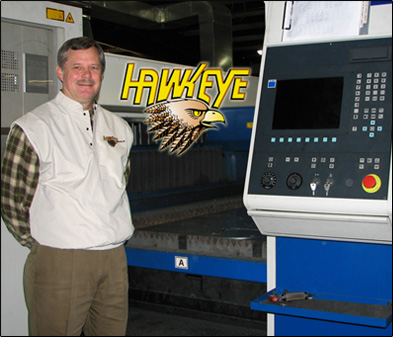 |
Fast forward 22 years and Hawkins is proudly accepting the Small Business Administration award as Mississippi's 'Small Businessman Of The Year for 2003.' His Hawkeye Industries, was just eight years old at the time, but it had established a reputation as the premier sheet metal fabrication job shop in Mississippi. An ISO9001:2000 certified business, Hawkeye had 24 employees and 11 state-of-the-art machine tools running 24 hours a day. It was then, and remains today, a showplace for the latest laser, welding punching, press brake and CAD/CAM technology.
A year later, Hawkeye's steel supplier brought in sheets of a new material called SCS and asked Bryan to try it. "I wasn't looking for, nor was I expecting productivity gains from my steel – I
|
 |
Bryan Hawkins at the control of his Trumpf L3040 Laser Cell - the first
one installed in the United States and one of three lasers now cutting
SCS in the 54,000 sq. ft. Hawkeye Industries manufacturing center. |
wanted better paintability," he recalls.
"I certainly got that. Our painter loves
SCS because he can use a less
aggressive wash cycle and still get |
|
a great finish. So I told that salesman |
to bring in more SCS, but consistently getting enough sheets in the right gauges was a problem. Not enough SCS was being produced at the time."
By 2006, the SCS supply was stable so Hawkeye started using it exclusively for certain parts. "That's when SCS took our productivity to a new level," observes Hawkins. "New laser units like ours are fast to start with, but SCS gives us another 15 to 25% speed improvement over P&O. What's more, our products are more accurate, our scrap is down, and our customers love it."
|
Hawkins points out how the SCS fabrication guidelines are key to gaining such advantages. "We find the settings for laser cutting, welding and pre-treating SCS are very important and, fortunately, not difficult to implement at all. But we must also be sure our customer is aware of them for any processing they do with the parts we supply. For example, following the SCS welding guidelines we get less spatter and better weld penetration than we can with P&O, but one customer wasn't happy welding SCS until we provided them with the SCS guidelines to follow."
Though he can't put a hard number to it, he also sees SCS' cleanliness as enhancing productivity. "We're kinda anal about keeping our shop clean and SCS makes it much easier. Rust resistance is also a big benefit. After handling and lasering P&O, we'd often have rust develop, even in our climate-controlled shop. Not with SCS."
|
Hawkins summarizes, "I've learned a lot since that failed tool and die shop, and I've got a 'hawk's eye' and a hound's nose for productivity and quality advantages in manufacturing. I'll sniff out the best equipment, the best process flow and great people to make it all work. When I sniffed out a better steel in SCS, our people adapted our processes and our top-notch equipment to get the most from it. The result: our work cells run faster, our deliveries are better and quality has improved. All from switching to a better material that doesn't cost a dime more than what we were using before. For someone used to spending $1 million to $2 million a year for the newest machine tool technology, the economics of SCS are a huge advantage for me, my employees, and for my customers."
|
|
 |

